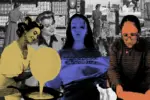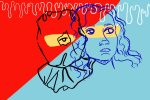“In fourteen hundred ninety-two, Columbus sailed the ocean blue.” If you went to any elementary school in America, you probably learned this poem, or at least the one stanza, to help you remember when and what Italian explorer Christopher Columbus discovered. You probably also learned that Columbus was the first man to discover the Americas in his failed attempt to reach India.
Then, in middle or high school you came to realize that your entire life was a lie—or at least that one tiny aspect of it. Columbus wasn’t the first man to discover the Americas, because it had already been inhabited by natives. Hell, he wasn’t even the first outsider to reach America, that man was Leif Erickson in 1000 A.D. Knowing this, it kind of makes you wonder what else teachers have said that are complete lies, and that is where I come in. Here are some things that you may have been taught in school, or by word of mouth, that are completely wrong.
Newton’s Apple
Myth: A young Issac Newton was sitting underneath an apple tree, thinking about the universe (how relatable) when suddenly an apple falls onto his head. Aha! Suddenly, in that moment, he understands everything about gravity: the same force that caused the apple to hit his head also keeps the moon, Earth, and sun in place and keeps earth-dwellers from floating off into the darkness of space.
Truth: It is pretty much impossible for something like getting hit with an apple to trigger a eureka moment and show you all of the answers to something as complex as gravity. Even now, generations later, scientists still don’t fully understand the force. Plus, if an apple hit me over the head, my first thought would be “ow.”
We actually find the truth in Newton’s biography “Memoirs of Sir Issac Newton’s Life,” where author William Stukeley told the story of when Newton shared his first thoughts on the theory of gravity. “It was occasion’d by the fall of an apple, as he sat in contemplative mood. Why should that apple always descend perpendicularly to the ground, thought he to himself…” writes Stukeley. So, while an apple was involved, the man didn’t just come up with everything that second. Instead, it took roughly two years for Newton to perfect his theory of universal gravity.
Thomas Edison’s Light Bulb
Myth: Thomas Edison was an American inventor and businessman, credited for inventing various things, including the motion picture camera, the phonograph and perhaps his most-credited invention: the light bulb.
Truth: The first electric lamp, called the electric arc lamp, was invented seventy years before by Humphry Davey, an English chemist and inventor. However, it wasn’t practical because it burned out too quickly and was too bright. In 1840, scientist Warren de la Rue created a more efficient light bulb, but it was too expensive for commercial production. In 1848, William Staite improved the longevity of arc lamps but, again, cost was an issue because the batteries were too expensive. Eventually, after buying the patent from the widow of inventor Heinrich Goebel, issues with said patent, and a whole lot of competition with Joseph Swan, Edison and his team perfected the light bulb in 1879. The Edison light bulb would be the first for practical and affordable home illumination. Truthfully, a majority of Edison’s inventions were created with the help of others.
The Trojan Horse
Myth: As mentioned in the “Odyssey,” after an unsuccessful ten-year siege, the Greeks offered their enemy a giant, wooden horse as a gift and offering to the goddess Athena. Feeling victorious, the Trojans proceeded to bring the horse within the walls of Troy, and when night fell, the Greek warriors concealed inside it climbed out and destroyed the city. This incredible war-strategy then gave the Greeks the upper hand.
Truth: According to Dr. Armand D’Angour, an associate professor and classicist at Oxford University, archaeological evidence shows that Troy was burned down as stated in the myth, but the giant wooden horse is completely made up. The horse may have been a battering ram or siege machine, resembling a horse. The idea of the Trojan horse could have also been inspired by the way ancient siege-engines clothed themselves in damp horse-hides to stop themselves from catching fire when hit with flaming arrows.
The Salem Witch Trials
Myth: In 1692, a group of girls in Salem, Massachusetts were overcome by disturbing fits, including seizures, violent contortions and hellish screams. When a doctor diagnosed the girls as victims of black magic, it created an epidemic of suspected witchcraft over the next several months. In the end, twenty people were executed as witches by being burned at the stake.
Truth: While the witch pandemic was a very real occurrence, none of the accused were burned at the stake. Nineteen of the victims were taken to Gallows Hill to die by hanging and Giles Corey was stoned to death when he refused to plead innocent or guilty. Other accused witches and sorcerers met their deaths while awaiting trial. The burning at the stake myth was popularized because during the European witch trials, execution by fire was common. Medieval laws in Germany, Italy, Scotland, France and Scandinavia stated that witchcraft was to be punished by fire. So, burning people alive was actually a European thing, not American.
Overall, I think the lesson here is to not take everything you are told at face value. Even though teachers might not intentionally be telling students incorrect historical “facts,” years and years of false tellings have lead to a lot of false truths. A big majority of the history we are told in school is either fabricated or there are details conveniently left out that skew the truth; it’s like a giant, messy game of telephone. Some people may not care that they’re being told half truths and full lies, but if it bothers you, the best thing you can do is to go back and fact check something that sounds like it might be off. There are a lot of truths to be found after all; as for the Newton, Edison, Troy and Salem myths: busted.

















